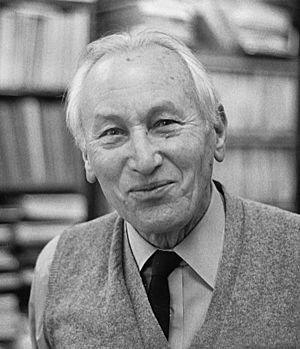Kenneth V. Thimann facts for kids
Kenneth Vivian Thimann (born August 5, 1904 – died January 15, 1997) was an important scientist. He was an English-American plant physiologist and microbiologist. This means he studied how plants work and tiny living things like bacteria. He was famous for his work on plant hormones. These are like chemical messengers that control plant growth. His discoveries helped a lot in agriculture (farming) and horticulture (gardening).
One of his biggest achievements was finding and understanding auxin. Auxin was the very first plant hormone ever discovered! Dr. Thimann worked at Harvard University for many years. Later, he moved to the University of California, Santa Cruz.
Contents
Early Life and Education
Kenneth Thimann was born in Ashford, England. He loved learning about science. He studied chemistry and biochemistry at Imperial College, University of London. There, he earned both his first degree (B.Sc.) and his Ph.D. He also received a special diploma from the University of Graz in Austria.
Starting His Scientific Journey
After finishing his studies, Dr. Thimann taught at the University of London for several years. In 1930, he moved to the United States. He began working at the California Institute of Technology. This was a big step in his career.
Discoveries and Harvard Years
In 1935, Dr. Thimann joined the Biology department at Harvard University. This is where he did much of his groundbreaking work. He became a leading expert on plant hormones.
Understanding Plant Hormones
In 1937, he co-wrote an important book called Phytohormones. He wrote it with F. W. Went. This book helped other scientists learn about plant hormones. Dr. Thimann was elected to the American Academy of Arts and Sciences in 1938. This showed how much his work was valued.
Leading Biological Research
From 1946 to 1950, Dr. Thimann was the director of Harvard's Biological Laboratories. This was a big responsibility. In 1948, he was elected to the United States National Academy of Sciences. This is a very high honor for scientists in the U.S.
Exploring the World of Bacteria
Dr. Thimann also studied tiny living things. In 1955, he wrote another important book called The Life of Bacteria. This book was very helpful for people studying microbiology. In 1959, he became a member of the American Philosophical Society. Before leaving Harvard in 1965, he was the Higgins Professor of Biology.
Building a New University
In 1965, Dr. Thimann moved to the University of California, Santa Cruz (UCSC). This university was brand new that year! He became the first provost of Crown College. A provost is like a head of a college within a university.
Shaping Science at UCSC
Dr. Thimann played a huge role in building the science departments at UCSC. He helped create the programs and bring in new scientists. He also helped develop the UCSC Arboretum. This is a special garden with many different kinds of plants. It is used for both research and education.
Later Years and Recognition
Dr. Thimann retired as provost in 1972. However, he stayed at UCSC until 1989. In 1977, he wrote another book, Hormone Action in the Whole Life of Plants. In 1982, he received the Balzan Prize. This award recognized his amazing contributions to botany, the study of plants. He moved to Haverford, Pennsylvania in 1989.


